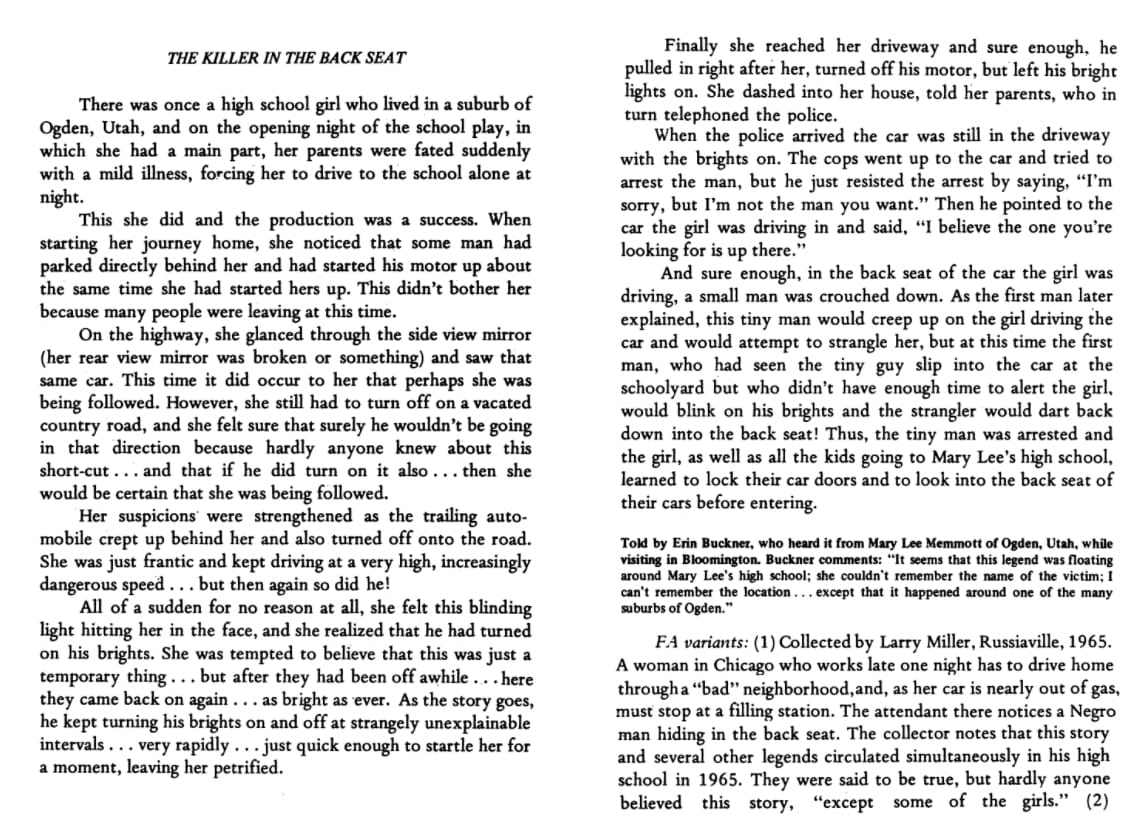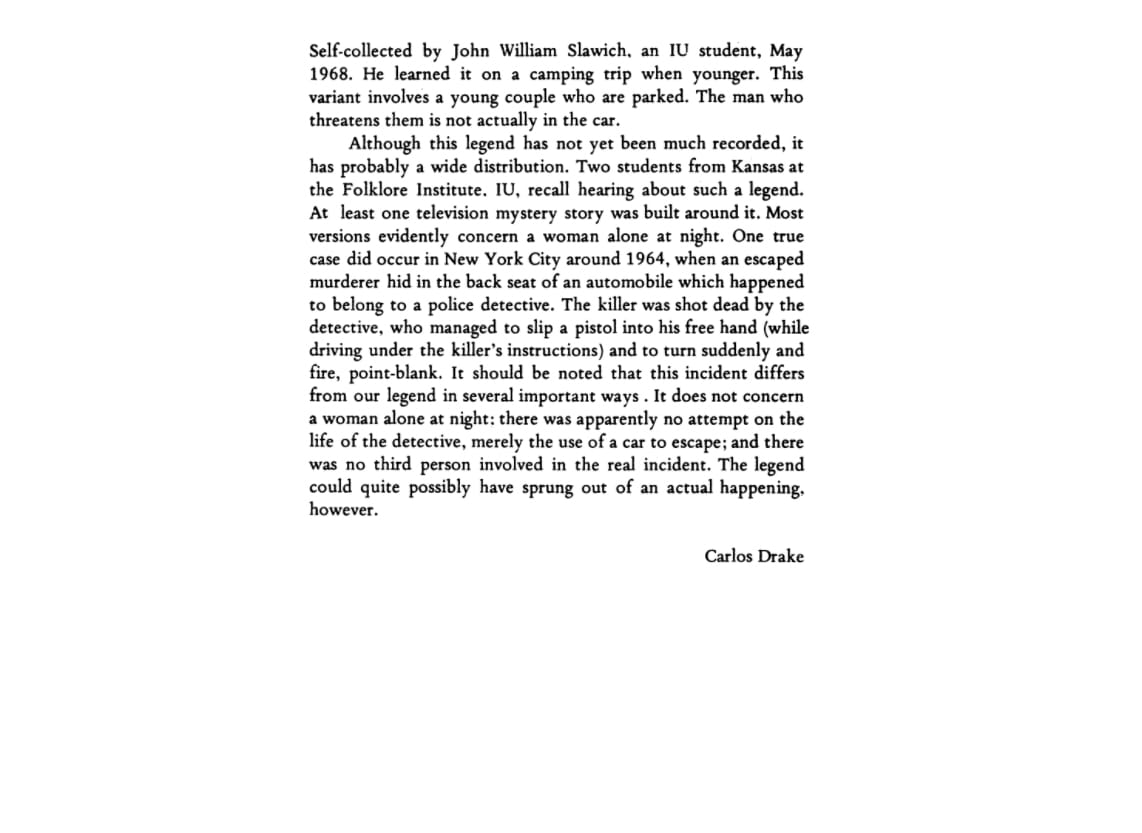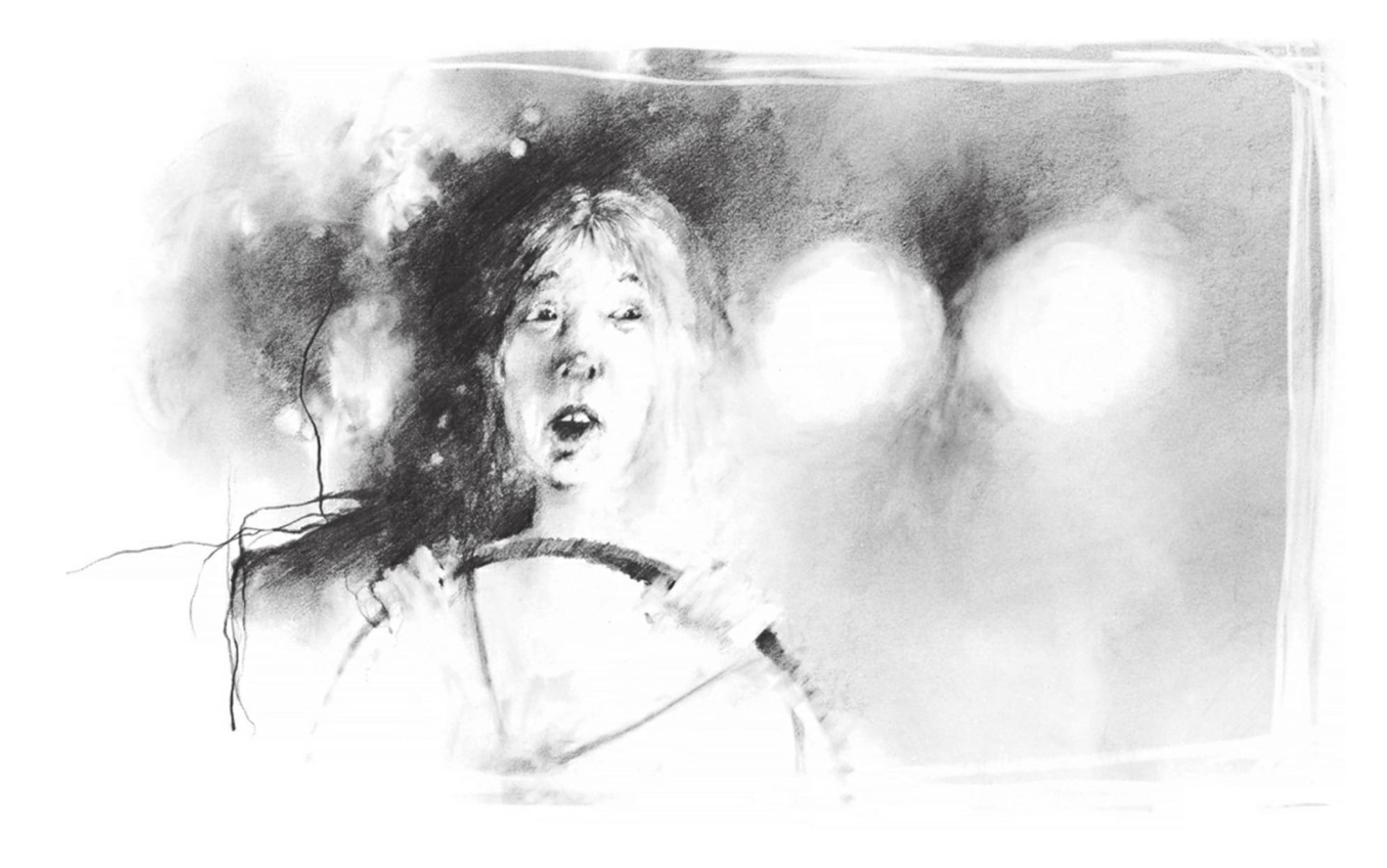I made a documentary about Scary Stories to Tell in the Dark. (Now available to watch.) The three books consisted of over 80 stories of folklore and urban legends. It was impossible to appropriately address each and every story in a single documentary. This website, in part, is a chance to look at individual stories that I researched, tales in which I learned about their origins and social contexts. It’s a chance to examine stories that I ultimately found to be fascinating in some way or another.
This is High Beams.
Many scary stories and urban legends stem from technologies and new developments that young people are venturing into. These often come from parents, their own new form of cautionary tales. Many that became prevalent in the mid to late 20th Century stem from these new technologies… the call is coming from upstairs “babysitter” story stems from teenagers being left home with only a landline phone… don’t trust strangers coming in the house through this new form of communication, a phone call.
And then there is the new thing that teenagers were very interested in starting in the 1950s and 60s, and that is cars and driving. Urban legends such as the hookman have a direct connection to young people driving on their own for the first time in that era.
The other very common story associated with teenagers and cars is the killer in the backseat legend. Many were first introduced to this story in the 1980s in the form of the Scary Stories books with its “High Beams” story, but the tale has an interesting and diverse background.
The Story of High Beams
Here is the full version of the scary story “High Beams” which was in the first of the Scary Stories to Tell in the Dark books. The story had a long history before 1981 when Alvin Schwartz included it in his collection, but we’ll get to that.
The girl driving the old blue sedan was a senior at the high school. She lived on a farm about eight miles away and used the car to drive back and forth. She had driven into town that night to see a basketball game. Now she was on her way home. As she pulled away from the school, she noticed a red pick-up truck follow her out of the parking lot.
A few minutes later the truck was still behind her. “I guess we’re going in the same direction,” she thought. She began to watch the truck in her mirror. When she changed her speed, the driver of the truck changed his speed. When she passed a car, so did he. Then he turned on his high beams, flooding her car with light. He left them on for almost a minute. “He probably wants to pass me,” she thought. But she was becoming uneasy. Usually she drove home over the back road. Not too many people went that way. But when she turned onto that road, so did the truck.
“I’ve got to get away from him,” she thought, and began to drive faster. Then he turned his high beams on again. After a minute, he turned them off. Then he turned them on again and off again. She drove even faster, but the truck driver stayed right behind her. Then he turned his high beams on again. Once more her car was ablaze with light. “What is he doing?” she wondered. “What does he want?” Then he turned them off again. But a minute later he had them on again, And left them on.
At last she pulled into her driveway, and the truck pulled in right behind her. She jumped from the car and to the house. “Call the police!” she screamed at her father. Out in the driveway she could see the driver of the truck. He had a gun in his hand. When the police arrived, they started to arrest him, but he pointed to the girls’ car. “You don’t want me,” he said. “You want him.”
Crouched behind the driver’s seat, there was a man with a knife. As the driver of the truck explained it, the man slipped into the girl’s car just before she left the school. He saw it happen, but there was no way he could stop it. He thought about getting the police, but he was afraid to leave her. So he followed her car. Each time the man in the back seat reached up to over power her, the driver of the truck turned on his high beams, Then the man dropped down, afraid that someone might see him.
Variations and Origins of The Killer in the Backseat Legend
The main source for Alvin Schwartz’s version of the High Beams story comes from Carlos C. Drake in Indiana Folklore (1968), one of many university folklore journals that collected such urban legends. Screenshots of that text is below. Along with having some notable differences from how Alvin Schwartz adapted the story, it also lists various origins and other variations.


Immediately one notices that oftentimes a folklorist would include very specific details about location. In this case, it is a suburb of Ogden, Utah, because he is using a specific telling from someone he interviewed. While Alvin Schwartz in his Scary Stories to Tell in the Dark includes details such as it being a blue Sedan, he omits any specific locations and includes details like “a farm about eight miles away” as a way to make it applicable to all kids and their retelling. It’s a way of saying, this could happen anywhere, even if you read the backmatter of the book and find that there are some specific sources for the tale. Because these are folklore and urban legends; it has spread over time and regions and so many people tell it as if it happened in their own backyard or the town just nearby.
This speaks to the difference between a folklorist and a storyteller writing for children, such as Alvin Schwartz. A folklorist can be thought of as someone who documents, while an author in the case of Scary Stories to Tell in the Dark ultimately is entertaining readers, while imparting some interesting history along the way. Both are needed and have their place, but they are different. A modern analogy might be a website like Snopes.com that may tell a version of the tale but ultimately is there to document the story and perhaps find an origin and report on whether the story has any basis in facts, as opposed to an author who is repackaging the story to entertain his or her audience or even a web forum where people share versions of their favorite scary stories as a way to scare each other. In the different goals, we find that embellishment and changing the story to fit the purpose is a prime difference between them.
Even this website, ScaryStudies.com, we have examples of articles meant to inform, research, and dissect. I’m not currently trying to scare you with this article.
As noted in Carlos Drake’s academic journal entry as well as many others who write about the killer in the backseat legend, ultimately the story is so widespread, it’s impossible to find a specific origin. Because there likely is not one. He notes a particular one in New York City around 1964, but it varies significantly from what the story eventually became. (I personally found that origin interestingly similar to the Paul Stine murder of the Zodiac killer.)
Most versions evolved into a cautionary tale involving an (often young) woman and getting in a car without checking the backseat, and in many cases it involves stopping at a gas station. The High Beams version of the story is similar to many others, which builds the tension by having someone increasingly alert the woman by flashing lights. This allows for a twist in the end where it was not the other driver on the road, but someone who is already inside the car. In this way, it has direct comparisons to the babysitter story in which the scary stranger is already inside and ready to pounce.
When noting various versions of the killer in the backseat legend, we can also draw attention to the many adaptations in film, television, and online.
For example, it was adapted in 1998’s Urban Legend.
And it was adapted into a short film called Suspicious (1994) starring Janeane Garofalo and Michael Rooker, directed by David Koepp who went on to direct Stir of Echoes and write Jurassic Park, Spider-Man, and much more. This version is similar to the High Beams story not because there are high beam lights involved, but rather that we have someone like Michael Rooker who appears to be the person that Jeanine Garafalo should be fearful of, when ultimately there is a twist involving the backseat killer.
Meaning of the High Beams Story and the Killer in the Backseat Legend
The killer in the backseat legend is a cautionary tale, as many are. Meaning is often found not in the story itself, but the variations of the story and the history and background of when it became prevalent. In this case, as stated, it was a time when young people were driving alone more, so encouraging them to be aware of their surroundings seems like an obvious direction to go for spook stories and urban legends.
— FOUNDATIONS OF HORROR —
Further explore these subgenres & tropes. more>>
#Scary Stories to Tell in the Dark | #Folk horror | #Slasher horror

You’ll also notice in Carlos Drake’s account that there are listed several other variations, and some of them allude to some problematic versions. It’s apparent that people were warning others that going to certain “bad” areas means that you could come across a scary “Negro” man that could get in your car. This is common. After documenting many of these stories, it is clear that many old scary stories are meant to scare children by using “otherness” as a source for terror… which means an underlying bigotry that can’t be ignored, while also (I don’t think) should subject the stories to the dust bins of history. I strongly believe our history should not be discarded because of problematic portions of it. And scary stories are a right of passage for children.
Most old stories have problematic pasts. In the case of the Scary Stories to Tell in the Dark books, a story like The Viper has connotations of being fearful of foreigners and the way they speak, a story like The Drum instills a fear of “gypsy” girls, or the story of The Alligator and parallels between shapeshifters and marrying people of a different land or ethnicity. Should we completely toss these stories? No. We can acknowledge their history while reinventing them for new generations.
Last Updated on May 24, 2022.


1 Comment